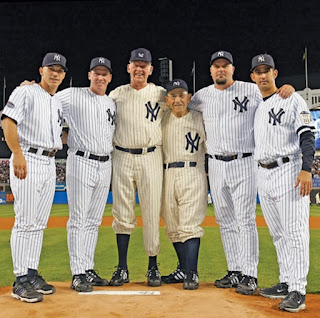1926 St. Louis Cardinals
The St. Louis Cardinals are the most successful National League franchise in baseball. Their 11 championships are 2nd only to the Yankees, and their 19 NL pennants are the most of any team that never played in New York (or 3rd overall if you wanna be specific). The winning began in 1926 and the circumstances and ending to that series would go down as one of the more unique in history.
The 1926 pennant run for the NL crown turned out to be a competitive one, as no one would win even 90 games and the top half of the league was always within striking distance of the lead. The Rogers Hornsby led (his lone full season as player-manager) Cardinals would go 89-65 and hold off the 2nd place Reds by just 2 games. Waiting for them in the World Series, as it would turn out to be more often than not in those days, was the New York Yankees.
Perhaps it was the events of 1926 that would give them the drive to become Murderer's Row the next season, but the Yankees were still seen as formidable going into this series. They only had 1 title in their history to this point, but this was already their 4th World Series appearance in 6 years and they had Babe Ruth in the prime of his glory, while the Cardinals were making their WS debut.
Through the first 6 games, the teams would match each other blow for blow, going into the pivotal Game 7 tied 3-3. The Cardinals took advantage of sloppy defense to take a 3-2 lead, but Jesse Haines got into trouble in the 7th inning. With the bases loaded and 2 out, future Hall of Famer Tony Lazzeri stepped up to the plate. Into the game to pitch came another future Hall of Famer to face him in Grover Cleveland Alexander. (It's worth noting for fairness that Jesse Haines was also a future Hall of Famer). Alexander had already pitched a CG victory the day before, but there was no time to be tired, this is Game 7 of the World Series where there is no tomorrow and you have all winter to rest so get back out there!
After Lazzeri hit a heart stopping foul ball, Alexander, still seeking his first championship in his proud career, was able to take advantage of his second chance and strike Lazzeri out. After an uneventful 8th inning, Alexander was still out there to try for his only career postseason Save. With 2 outs, Babe Ruth stepped up to hit. He already had a Home Run that day but Alexander wanted no part in intentionally walking the slugger. With a full count, Alexander delivered a close pitch that Babe took for ball four, and took 1st anyway.
Grover barely had a chance to throw the first pitch to the next batter when Ruth made the bold decision to steal 2nd base, later saying (in less tasteful language, because it's Babe Ruth) that he was not doing any good standing on 1st base. 1926 MVP Bob O'Farrell caught the swinging strike and hurled it to 2nd base, where Hornsby had just enough time to apply the tag to the sliding Ruth and secure the 3rd out and the championship. To this day it remains the only time in history that a World Series ended on a Caught Stealing.

































